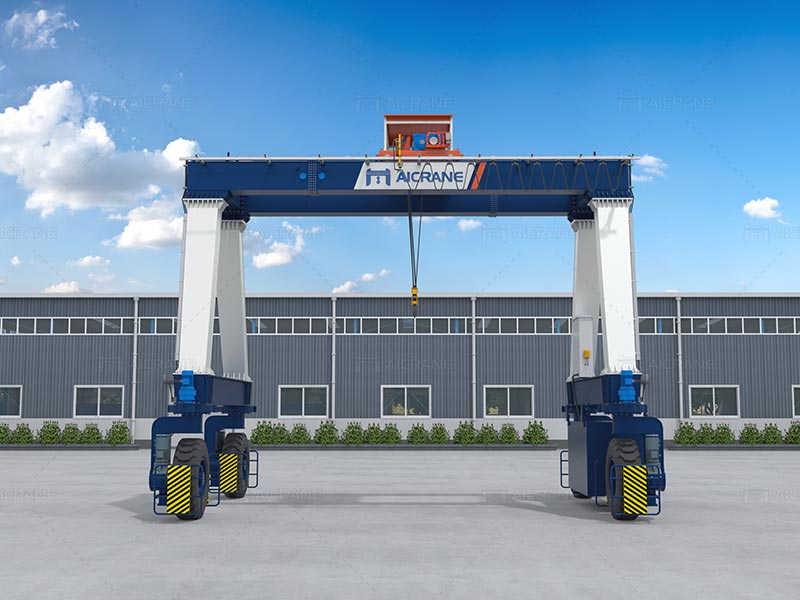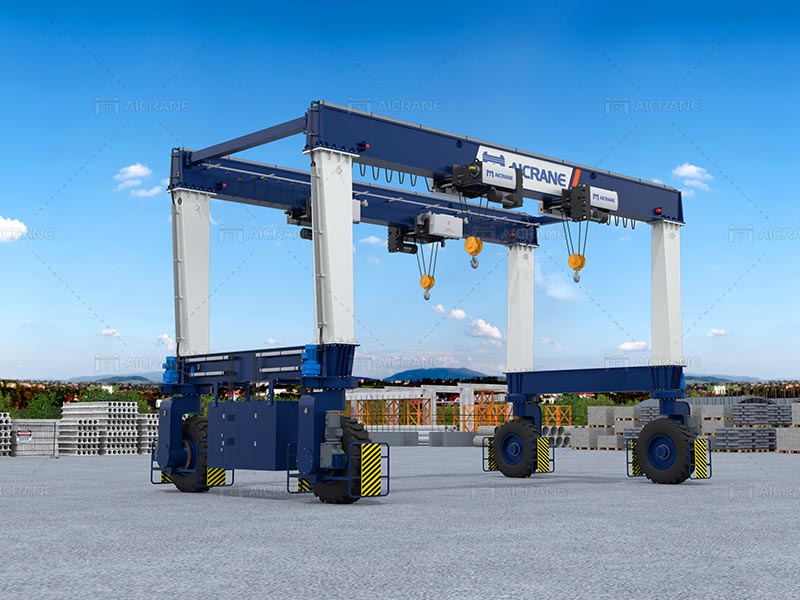A 30 ton gantry crane is a versatile and powerful piece of equipment widely used in construction, manufacturing, and industrial settings. Its primary function is to lift and transport heavy loads efficiently and safely. While these cranes are engineered to handle a variety of materials, equipment, and components, it’s essential to understand what specific tasks and weights they can handle to ensure safe and effective operations.
In this passage, we will explore the capabilities of a 30 ton gantry crane, the types of materials and applications it can handle, and the best practices to ensure safe operation.

Overview of a 30 Ton Gantry Crane
Gantry cranes are designed to lift and move loads vertically and horizontally using a trolley and hoist system. They consist of a bridge supported by vertical legs, which can be fixed or mobile. A 30 ton gantry crane is rated for a maximum lifting capacity of 30 tons (60,000 pounds or 27,216 kilograms). This capacity determines the crane’s ability to lift loads without exceeding safety limits, ensuring smooth and safe operation.
Gantry cranes can be classified into several types based on their design and application:
Single-girder gantry cranes: A lighter option with a single beam supporting the trolley, generally used for lighter, more flexible applications.
Double-girder gantry cranes: Featuring two beams for added strength and stability, they are typically used for heavy-duty tasks and more demanding environments.
Rail-mounted gantry cranes (RMGs): These rmg cranes run on rails and are commonly used in container yards and shipping ports.
Rubber-tired gantry cranes (RTGs): Equipped with wheels for mobility, RTGs are ideal for applications where flexibility in movement is needed.
Regardless of the specific type, a 30 ton gantry crane is capable of handling a wide variety of heavy materials, equipment, and components. Let’s explore the types of tasks this crane can perform safely.
What Can a 30 Ton Gantry Crane Handle Safely?
The ability of a 30 ton gantry crane to lift and transport heavy materials is invaluable in many industries. Here are some of the key materials and components that a 30 ton gantry crane can handle safely:
1. Steel Components and Structures
In construction and manufacturing industries, steel beams, girders, and structural components are frequently lifted and moved using gantry cranes. These materials are often bulky and heavy, making a 30 ton crane an ideal choice for hoisting them safely and efficiently. The crane’s precision ensures that steel components are positioned accurately for assembly in large construction projects such as bridges, skyscrapers, and industrial buildings.
For example, a 30 ton gantry crane can easily lift prefabricated steel frames and columns, weighing several tons each, and position them accurately for installation. Additionally, it can move large steel plates or heavy-duty pipes in a fabrication yard or construction site.
2. Concrete Segments and Precast Elements
Concrete is a fundamental material in construction, and precast concrete elements—such as slabs, beams, columns, and panels—are often required to be lifted and transported. A 30 ton gantry crane is ideal for safely handling these heavy elements, which can weigh several tons individually.
In infrastructure projects like road construction, bridges, and tunnels, the crane can be used to lift concrete precast components or large concrete blocks used for retaining walls. For example, in a bridge-building project, a 30 ton gantry crane might be tasked with lifting and positioning heavy concrete girders that form the main support structure.
3. Containers in Shipping and Logistics
One of the most common applications of gantry cranes, particularly rail-mounted gantry cranes (RMGs) and rubber-tired gantry cranes (https://aicranemachine.com/gantry-crane/rubber-tyred/), is the handling of containers in ports and intermodal terminals. A 30 ton gantry crane is capable of lifting fully loaded shipping containers that weigh up to 30 tons, which is crucial in the logistics industry.
These cranes allow operators to safely move containers from ships to trucks or trains, stacking and organizing them efficiently in storage areas. The use of a 30 ton gantry crane in this capacity ensures that the containers are handled safely, without exceeding the weight limit, and helps streamline the logistics process.
4. Heavy Machinery and Equipment
In industrial settings, such as factories, workshops, and mining operations, heavy machinery and industrial equipment need to be lifted, relocated, or installed. Examples of equipment that can be handled by a 30 ton gantry crane include:
Industrial presses
Generators and turbines
Large pumps and compressors
Mining equipment such as crushers and grinders
Whether the task involves relocating equipment within a facility or lifting machinery for installation or repair, a 30 ton gantry crane provides the strength and stability to perform these tasks safely.
5. Heavy-Duty Vehicles and Parts
In automotive manufacturing, heavy-duty vehicle repair shops, or shipyards, a 30 ton gantry crane can safely handle large vehicle parts, such as engine blocks, chassis components, or ship parts. For example, in shipbuilding, gantry cranes are used to move heavy sections of ships, such as hull segments or engine components.
In the automotive industry, the crane can lift industrial vehicle components, such as frames or body parts, during assembly or repair processes. Its lifting capacity ensures that even the heaviest parts are transported and positioned without exceeding safe working limits.
6. Wind Turbine Components
As renewable energy continues to grow, wind farms are becoming more prevalent. The installation and maintenance of wind turbines require the handling of large and heavy components, such as turbine blades, nacelles, and tower sections. A 30 ton gantry crane is perfectly suited for lifting these components during assembly.
For instance, a wind turbine nacelle, which houses the generator and other critical components, can weigh up to 20 tons. The crane can lift and position these nacelles during the turbine assembly process, ensuring precision and safety.

Best Practices for Safe Handling with a 30 Ton Gantry Crane
While a 30 ton gantry crane is designed to handle heavy loads, following best practices ensures safe operation. Here are some important safety tips:
1. Weight Distribution and Load Assessment
Before lifting any load, operators must assess its total weight and ensure it does not exceed the crane’s 30-ton capacity. Proper weight distribution is crucial to avoid overloading one side of the crane, which could lead to tipping or equipment damage.
2. Regular Maintenance and Inspections
To ensure that the crane operates safely, regular maintenance and inspections are critical. Operators should check the condition of the hoist, trolley, and crane rails before use, inspecting for any signs of wear, rust, or damage. Lubricating moving parts and tightening bolts can prevent mechanical failures during operation.
3. Proper Load Securing
Operators must use the appropriate lifting slings, hooks, and chains to secure the load before lifting. The load should be balanced, and the crane must lift it smoothly to prevent swaying or instability.
4. Operator Training and Certification
Only trained and certified personnel should operate a 30 ton gantry crane. Proper training ensures that operators understand the crane’s capabilities, how to control it, and how to respond to potential safety issues.
5. Adherence to Safety Protocols
Safety protocols, such as wearing personal protective equipment (PPE), clearing the area beneath the crane during lifting operations, and following load limit guidelines, must be strictly followed to prevent accidents.
A 30 ton gantry crane is a highly efficient and versatile tool for handling a wide range of heavy loads in construction, manufacturing, logistics, and industrial settings. From lifting steel components and precast concrete elements to transporting fully loaded containers and heavy machinery, this crane is engineered to perform various tasks safely and effectively.
By understanding its capabilities and following proper safety protocols, operators can ensure that the crane handles its tasks safely, maximizing productivity while minimizing the risk of accidents or equipment failure. Whether it’s for a construction site, a factory, or a port, a 30 ton gantry crane is an indispensable tool for managing heavy loads with precision and ease.